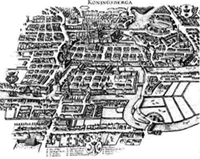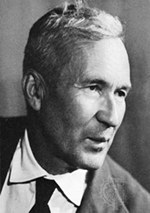 The website is in construction. New files will be uploaded as soon as they are available.
The website is in construction. New files will be uploaded as soon as they are available.
JÜRGEN MOSER
Königsberg, Germany (now Kaliningrad, Russia) 1928 - Zürich, Switzerland 1999

- Brief scientific biography
- Quotations relevant to mathematics education
- Primary bibliography
- Secondary bibliography
Brief scientific biography
Jürgen Moser was one of the most profound analysts of the last half century. His work ranged over different fields of mathematics, both pure and applied. Much of his deepest work was concerned with dynamical systems, especially small divisor problems and relations with celestial mechanics. He also did fundamental work in functional analysis - the Nash-Moser theory - and partial differential equations, and he made deep contributions in completely integrable systems, geometry, and complex analysis. Moser was also a master of exposition. His papers and published lectures are beautifully written.Jürgen Kurt Moser was born on 4 July 1928 in Königsberg, then an eastern outpost of Germany, now the Russian city of Kaliningrad. He attended the Gymnasium in Königsberg but when he was fifteen years old he was forced into a military auxiliary force. After the end of the war he studied at the University of Göttingen.
Louis Nirenberg, quoted in (MATHER, MCKEAN, NIRENBERG, RABINOWITZ 2000, p. 1398).
In Göttingen Moser studied the spectral theory of differential equations with the South-Tyrolian mathematician Franz Rellich (1906-1955). Moreover Carl Ludwig Siegel (1896-1981), who returned to Göttingen in 1951, became a major influence on Moser, who acquired an interest in astronomy and number theory through him. In 1952 Moser was awarded his doctorate from Göttingen University.
Moser remained in Göttingen until 1953 when he went to the United States to spend a year at New York University on a Fulbright Scholarship. After working for a year at the Courant Institute, he returned to Germany, where he was an assistant to Carl Siegel at Göttingen University in the academic year 1954-1955. During this period he took notes of Siegel's lectures, which first became the basis for a book by Siegel published in 1956, then later became the basis of a joint book Lectures on celestial mechanics (1971) (O'CONNOR, ROBERTSON 2006).

Königsberg
In 1955 Moser emigrated to the United States, where he married Gertrude Courant on 10 September 1955. They had two daughters, Nina and Lucy.

Göttingen University
Jürgen Moser was appointed to New York University as an assistant professor in 1955. Then he went to the Massachusetts Institute of Technology in 1957. He spent 1961 as a Sloan Fellow and, since 1967 to 1970, he was Director of the Courant Institute.
In 1980 Moser left the United States and accepted a position at the Eidgenössische Technische Hochschule (ETH) in Zurich, where he was Director of its Research Institute for Mathematics from 1984 to 1995, when he was made Professor Emeritus.
Moser's mathematical interests included the theory of partial differential equations, spectral theory, dynamical systems, complete integrability, differential geometry, and complex analysis (LAX 2002).

Andrei Kolmogorov
He introduced some techniques which could be applied to almost any dynamical system of Hamiltonian type, and the "Moser twist stability theorem". When combined with the work of Vladimir Igorevich Arnold (born in 1937) this led to the so-called K.A.M. Theory. Based on ideas by Andrei Nikolaevich Kolmogorov (1903-1987), this important theory provided a new approach to stability problems in celestial mechanics (O'CONNOR, ROBERTSON 2006).

Vladimir Arnold
Moser was invited to give the Gibbs lecture of the American Mathematical Society in Dallas in 1973, the Pauli lectures at ETH in 1975, the American Mathematical Society Colloquium lectures in Toronto in 1976, the Hardy lectures in Cambridge in 1977, the Fermi lectures in Pisa in 1981, and the John von Neumann Lecture of the Society for Industrial and Applied Mathematics in Seattle in 1984. Elected to the National Academy of Sciences in 1973, he had been awarded its Craig Watson Medal in 1969 for his fundamental contributions to dynamic astronomy.

Jürgen Moser
He was President of the International Mathematical Union, and member ex officio of the ICMI Executive Committee, from 1983 to 1986, and was awarded many prizes, including AMS/SIAM Birkhoff Prize in Applied Mathematics (1968), Dutch Mathematical Society Brouwer Medal (1984), DVR Cantor Medal (1992), Wolf Prize (1994/1995), London Mathematical Society Honorary Membership (1996). In 1998 he was invited to address the International Congress of Mathematicians in Berlin, the third time he had been invited to address an International Congress.
Jürgen Moser, "one of the leading mathematicians of the postwar era", in Konrad Osterwalder's words, a colleague at Swiss Federal Institute of Technology, died on Friday 19 December 1999 in Schwerzenbach, Zurich, Switzerland.
Paul H. Rabinowitz, one of Moser's students, wrote (in MATHER, MCKEAN, NIRENBERG, RABI-NOWITZ 2000, p. 1393):
He was a lifelong music lover - he played the cello - and amateur astronomer. He enjoyed biking and swimming. At the age of sixty, he took up paragliding. With his untimely death at seventyone, many of us in the mathematics community lost a hero, friend, and mentor.
Quotations relevant to mathematics education
Peter Lax wrote:
Jürgen was very direct; he said what was on his mind, even when it was not what you had hoped to hear. But that only deepened his friendships, for his judgments were mostly right, and because everything he did was done with great kindness (LAX 2002).Paul H. Rabinowitz wrote:
To those who knew him Moser exemplified a creative scientist and, perhaps even more important, a human being. His standards were high and his taste impeccable. His papers were elegantly written. Not merely focused on his own research, he worked successfully for the well-being of mathematics in many ways. He stimulated several generations of younger people by his penetrating insights into their problems, scientific and otherwise, and by his warm and wise counsel, concern, and encouragement. My experience as his student was typical: then and after-wards I was made to feel like a member of his family (in MATHER, MCKEAN, NIRENBERG, RABINOWITZ 2000, p. 1393).
Primary bibliography
H. AIRAULT, H.P. MCKEAN, J. MOSER 1977, Rational and elliptic solutions of the Korteweg-de Vries equation and a related many-body problem, Comm. Pure Appl. Math. , 30, 95-148
S.S. CHERN, J.K. MOSER 1974/1983, Real hypersurfaces in complex manifolds, Acta Math. , 133, 219-271, Erratum, ibid. 150, 297
B. DACOROGNA, J. MOSER 1990, On a partial differential equation involving the Jacobian determinant,Annales Inst. H. Poincaré Anal. Non Linélaire, 7, 1-26
J.K. MOSER 1960, A new proof of de Giorgi's theorem concerning the regularity problem for ellip-tic differential equations, Comm. Pure Appl. Math. , 13, 457-468
J.K. MOSER 1961, On Harnack's theorem for elliptic differential equations, Comm. Pure Appl. Math., 14, 577-591
J.K. MOSER 1961, A new technique for the construction of solutions of nonlinear differential equations, Proc. Nat. Acad. Sci. USA, 47, 1824-1831
J.K. MOSER 1962, On invariant curves of area-preserving mappings of an annulus, Nachr. Akad. Wiss. Göttingen Math.-Phys. Kl., II, 1-20
J.K. MOSER 1964, A Harnack inequality for parabolic differential equations, Comm. Pure Appl. Math., 17, 101-134
J.K. MOSER 1965, On the volume elements on a manifold, Trans. Amer. Math. Soc., 120, 286-294
J.K. MOSER 1966, A rapidly convergent iteration method and non-linear partial differential equations I, Annali Scuola Norm. Sup. Pisa, (3)20, 265-315; II, 499-535
J.K. MOSER 1971, A sharp form of an inequality by N. Trudinger, Indiana Univ. Math. J., 20, 1077-1092
J.K. MOSER 1973, Stable and Random Motions in Dynamical Systems: With Special Emphasis on Celestial Mechanics, Ann. of Math. Studies, 77, Princeton, Princeton Univ. Press
J.K. MOSER 1973, On a nonlinear problem in differential geometry, Dynamical Systems (Proc. Sympos. Univ. Bahia, Salvador, 1971), Academic Press, New York, 273-280
J.K. MOSER 1975, Finitely many mass points on the line under the influence of an exponential potential - An integrable system, Dynamical Systems, Theory and Applications (Rencontres, Battelle Res. Inst., Seattle, WA, 1974) , Lecture Notes in Phys., 38, Springer, Berlin, 467-497
J.K. MOSER 1975, Three integrable Hamiltonian systems connected with isospectral deformations, Advances in Math., 16, 197-220
J.K. MOSER 1977, The scattering problem for some particle systems on the line, Geometry and Topology, Lecture Notes in Math., 597, Springer, Ber-lin, 441-463
J.K. MOSER 1980, Geometry of quadrics and spectral theory, The Chern Symposium 1979 (Proc. Internat. Sympos., Berkeley, CA, 1979), Springer, New York and Berlin, 147-188
J.K. MOSER 1988, Minimal foliations on a torus, Topics in Calculus of Variations, Springer Lecture Notes in Math., 1365, 62-99
Secondary bibliography
AA. VV. 2003, Dedicated to the memory of Jürgen K. Moser, Comm. Pure Appl. Math. 56(7), i-ii, 813-1028
AA. VV. 2003, Dedicated to the memory of Jürgen K. Moser, Comm. Pure Appl. Math. 56(8), i-ii, 1029-1245
V. ARNOLD 2000, J. Moser (1928-1999). Déclin des mathématiques (après la mort de Jürgen Moser), Gaz. Math., 84, 92-95
A. GIORGILLI 2000, A tribute to Jürgen Moser (1928-1999), Celestial Mech. Dynam. Astronom., 77(3), 153-155
B. HAssELBLATT, A. KATOK 2002, The development of dynamics in the 20th century and the contribution of Jürgen Moser, Ergodic Theory Dynam. Systems, 22(5), 1343-1364
P.D. LAX 2002, Jürgen Moser, 1928-1999, Ergodic Theory Dynam. Systems, 22(5), 1337-1342
J.N. MATHER, H.P. MCKEAN, L. NIRENBERG, P.H. RABINOWITZ 2000, Jürgen K. Moser (1928-1999), Notices Amer. Math. Soc., 47(11), 1392-1405
J.J. O'CONNOR, E.F. ROBERTSON 2006, Jürgen Kurt Moser, MacTutor History of Mathematics, http://www-history.mcs.st-andrews.ac.uk/Biographies/Hopf.html
E. J. ZEHNDER 1993, Cantor-Medaille für Jürgen Moser, Jahresber. Deutsch. Math.-Verein. 95(2), 85-94
E. J. ZEHNDER 1994, Hommage à Jürgen Moser,Gaz. Math., 59, 57-66
Author
Giorgio T. Bagni
Department of Mathematics and Computer Science
University of Udine - Italy
giorgio.bagni@dimi.uniud.it
